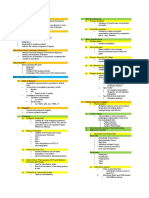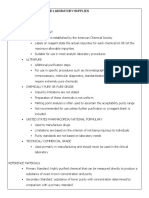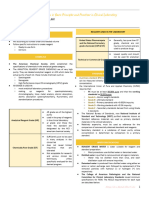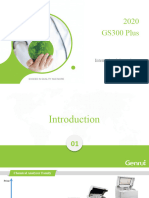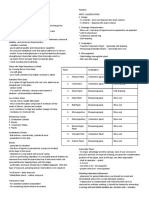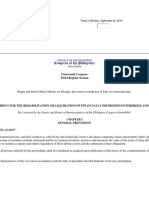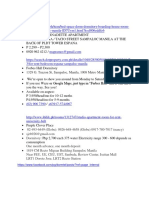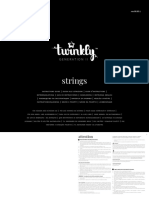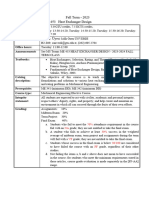Chapter 1
Basic Principles and Practice of Clinical
Chemistry, part 2
C. REAGENTS; Chemical Grades
Reagent preparation in the clinical lab is decreasing most reagents are obtained from commercial
manufacturers
Objective: Identify and differentiate the different degrees of chemical
purity.
Common terms that relate to reagent purity:
Analytical Grade (purest), also called reagent grade or
ACS grades - best choice for lab work.
National Formulary (NF) or US Pharmacopeia (USP)
used for drugs, may be OK for lab work
Chemical Pure (least pure) not recommended for lab
Technical or commercial grade never for lab use
REAGENTS; Chemical Grades
Primary Standard : Highly purified solution of known
concentration. These standards are used in the clinical
lab to calibrate / standardize instruments in order to
measure other solutions of unknown concentration
Primary Standards must be 99.98% pure
Secondary Standard : Less pure substance whose
concentration was determined by comparison to a
Primary Standard
Standard Reference Material / Calibrator
The name for biological substances used as
standards
Most biological standards cannot be 99.98%
pure because the chemical processes to achieve
this level of purity would destroy the substances.
Controls
For our purposes:
A control should have the same appearance
and consistency as does the patient samples:
Defined: substance, whose physical and
chemical properties resemble the unknown
specimen
If patient sample is serum; the control should look
like and have the same consistency as serum.
If the patient sample is urine, the control is urine,
etc.
- Controls are used to verify the accuracy
and acceptability of a run.
4
Control Solutions vs. Standard Solutions
A Control specimen is used to monitor Quality
Control (QC)
A Control has known acceptable ranges, established
either by the manufacturer (assayed) or the hospital
lab itself (un-assayed)
It is usually a serum/plasma based solution that is
treated just as if it were a patient specimen
Control specimens must produce results within
established ranges in order for the run to be
acceptable.
Control Solutions vs. Standard Solutions
A Standard solution is a highly purified solution that
is usually not serum / plasma based
Standard solutions have set, listed values that are
established by the manufacturer
Standard solutions are used to calibrate
instruments, that is to set instruments to measure
correctly at known concentration
Control Solutions vs. Standard Solutions
Standard solutions are also called Calibrators if
they are biological in nature
Consider for example, analytes such as bilirubin.
These substances do not come in the highly purified
state, as calcium, glucose, etc.
A bilirubin standard is biological based, and technically
a calibrator rather than the purely defined standard.
What about the hematology standards? Standard or
calibrator?
Water Specifications
Tap water is unsuitable for lab use (too many impurities)
Types of water purification techniques
Reagent Grades of water
Distillation removes most organic matter
Reverse osmosis
Filtration
Deionization ions removed
Type I
Purest Required for sensitive tests
Type II
Acceptable for most uses
Type III OK for washing glassware
CAP - QC of water : pH, electrical resistance, bacterial
culture
8
�Water filtration system for
Automated chemistry analyzer.
Use of Blanks
Review: Blanks used to eliminate or subtract the effects of
reagent or specimen colors that would interfere with
accurately measuring an analyte.
Water Blank DI water, used to zero the spectrophotometer.
Seen mostly in UV procedures.
Reagent Blank contains all the reagents used in the tests.
DI water sometimes used in the place of the amount of
patient specimen. Colorimetric procedures.
Patient Blank required by some procedures if patient
sample has deep color that would affect results. Name 3
situations that would warrant use of patient blank.
10
Labware
Types of glass
High thermal borosilicate
Can take long periods of high temperatures
Scratches easily
Acceptable for chemistry work
Examples: Pyrex, Kimax
11
Labware
Types of glass
Aluminosilicate
Can withstand heat as long as not in contact with
acids or alkalis
Resists scratching
Acceptable for chemistry work
Examples: centrifuge tubes, thermometers
12
Labware
Types of glass
Soda lime not suitable for lab use
13
Types of plastic resins
Polystyrene
Clear, rigid
Can withstand temperatures to 70 C
Examples: many disposables
14
Types of plastic resins
Polyethylene
Translucent in appearance
Two types
One type can withstand temperatures up to 80 C,
and is flexible, i.e., reagent wash bottles
Other can withstand temperatures up to 120 C and
is rigid, i.e., droppers
15
Types of plastic resins
Polyvinyl chloride
Translucent in appearance, but rigid
Withstands temperatures to 135 C
Examples: screw cap enclosures
16
Types of glassware
Beakers
Flasks
Volumetric
Erlenmeyer
Graduated cylinders
Reagent bottles
Test tubes
17
Pipets
Types
Volumetric
Volumetric pipets are TD, the most accurate and used to prepare
Standard solutions, Calibrators and Quality Control specimens
Ostwald-Folin
Capillary
Serologic
TD = to deliver
TC = to contain
Mohr
Transfer
Automatic and
semi-automatic
18
Laboratory Vessels and Pipets
Volumetric flasks : The line indicates the level that contains an exact volume
Erlenmeyer flasks : Hold variable volumes
Graduated cylinders : Hold variable volumes
Pipet rules
TC = needs to be blown out
TD = let drain along the side of the receiving vessel
Read pipets from the bottom of the meniscus
Hold pipets straight up and down
Use suction bulbs to aspirate fluids into pipets
NEVER MOUTH PIPET !!!
Place dirty pipets in soapy water with tips up
19
Proper use
Use correct pipet for the job
Examine the pipet before use for cleanliness, chips,
etc.
NEVER pipet by mouth
Draw the solution slightly above the mark
Wipe the tip with a Kimwipe
Correct and incorrect pipet
positions
20
Buret essentially an elaborate pipet
mounted on a stand used in titration
procedures
21
Cleaning of Lab Glassware
Majority of time can simply presoak, dishwash, and
thoroughly rinse with tap and finally
distilled/deionized water
Chemically clean glassware is required for certain
chemistry procedures (enzymes, iron, heavy metals,
etc.)
dichromate acid or acid dichromate
22
General Laboratory Equipment
Balances type chosen dependent on
volume/weight needed and degree of accuracy
required.
What is the best choice for clinical work?
23
General Laboratory Equipment
Centrifuge
Purpose
Types
Characteristics
Fixed rotor head / swinging bucket
Closing locked closed lid now required
24
General Laboratory Equipment
Other methods of separating materials
Filtration of materials
Dialysis - a method made popular by Technicon
Corporation (early manufacturer of automated lab
equipment). This method makes use of a semipermeable membrane that allows separation of
molecules using their size
25
Specimen Collection and Processing
Medical ethics in specimen collection
professionalism and confidentiality at all
times
Special collection procedures
Fasting specimens: overnight for most tests, 12 hours
for lipid studies
Timed interval specimens
Examples include glucose tolerance, therapeutic
drug monitoring, and hormone stimulation testing
In some cases urine collection also required
Legal chain of evidence
Other special collection procedures
26
Specimen processing
Determining specimen acceptability
Other than improper timing, identify things that can
affect chemical analysis of clinical specimens.
Specimen accessioning
27
Specimen processing
Serum separators covered in summer course
Gel barrier
Beads, crystals or fibers
Plastic tube device
28
Other / SPECIMEN CONSIDERATIONS
Specimen collection and processing are critical
A poor specimen = poor specimen results
Most lab errors are pre-analytical !!!
Common sources of error
Contamination with IV fluids
Hemolysis of RBCs contaminates plasma and
serum
Labeling errors
Collection with improper anticoagulants and
preservatives
Analyzers clogged by clotted specimens
29
The slides that follow are from another
information source and remain here only
for general use, at this time.
30
Collection tubes / Additives
Red
Red / Black
Lavender
Orange
Blue
Gray
Green
None
None Gel separator
EDTA anticoagulant
Thrombin promotes clotting
Sodium citrate anticoagulant
Sodium fluoride / Potassium oxalate
Heparin anticoagulant
Collection order ( to avoid contamination / interference )
1
2
3
4
5
6
Sterile specimens Blood Cultures (yellow)
Blue
Gold / Red / Orange
Green
Lavender
Gray
31
Colligative Properties
Properties of solutions that are based only on the numbers of particles
that are dissolved in the solvent
It doesnt matter what the particles are or how big they are
Examples of colligative properties
Freezing Point
Boiling Point
Vapor Pressure
Osmotic Pressure
32
Redox Potential ( Oxidation-Reduction Potential)
If a substance Gains Electrons , it is Reduced (GER)
It may also be called a Oxidizing Agent ( accepts
electrons)
Remember The lion ( LEO ) says gerr ( GER )
If a substance Loses Electrons , it is Oxidized (LEO)
It may also be called a Reducing Agent ( donates
electrons)
Conductivity: Measure of electrical current
Resistance:
Measure of resistance to current
33
pH and Buffers
1
H
Buffers resist change in acidity
Buffers are usually weak acids ( or bases) and their salts
pH is the unit used to measure acidity ( Hydrogen ion
concentration )
p = negative log of the concentration of a substance in
solution.
Example: pH = - log [H+]
The Hydrogen ion concentration of deionized H2O is 1 x 10-7 M
The negative log of 10-7 = 7. The pH of H2O is 7.0
The pH scale ranges from 0 - 14
pH 7 = neutral
pH > 7 = alkaline (basic)
pH < 7 = acid
34
�Significant Figures Rules
All non-zeros are significant
All zeros between non-zero numbers are significant
Zeros to the right of a number with a decimal place are significant
Zeros to the right of a number without a decimal place are not significant
Zeros to the left of a number with a decimal place are not significant
Examples of significant figures
9004
101
6.2
207.0
679.01
700
24300
0.0100
0.0004
4
3
2
4
5
1
3
3
1
35
Conversions
You must remember this, conversions do NOT
change the value of the concentration
Conversions only change the UNITS the value
is being expressed in.
Whatever we are converting is just as big or
small as before we did the conversion.
36
�Rules for Multiplication and Division of Significant Figures
Perform the multiplication and division as written
Round off your final answer to the least number of significant figures that
occurs in the original figures
Example
0.0211 2.53 13.82
1200
0.000614794
The figure with the least number of significant figures is 1200 ( it has 2 ).
Your answer cant have more significant figures than the weakest link in the chain
The answer must also be rounded off to 2 significant figures 0.00061
37
Example of a conversion
How many mls are there in 2.5 liters? ( this is an easy one )
The question you have to ask yourself is, what is the relationship between
liters and mls? The answer : 1 liter = 1000 ml This is a true statement
But now what?
We want to get rid of the liters units and end up with mls Right ?
So all you need to do is put in a truthful mathematical statement that gets rid
of the stuff you want to lose and adds the stuff you want to pick up So
1000 mls
2.5 Liter
2500 mls
1 Liter
THIS IS THE SECRET !!!
The fraction I created equals 1.0
It doesnt change the value!
I wrote it with the Liter on the bottom so it would cancel out the Liter on the top
and I also picked up the mls I need . All conversions use this strategy
38
�1.25 liters = _____ mls ?
Remember, write a fraction that does two things:
1. Equals 1
2. Gets rid of unwanted units and / or adds needed units
1 0 0 0 m ls
1 . 2 5 L i t e r s 1 L i t e r 1 2 5 0 m l s
100 mg =
_________ ug ?
1000 ug
1 0 0 m g 1 m g 1 0 , 0 0 0 0 u g
39
Another conversion example
Physiological Saline is used in Blood Banks and Hematology to prepare
Red Blood Cell suspensions.
Physiological Saline is usually listed as being 0.9 % NaCl
0.9 grams of NaCl is added to 100 mls deionized water to make
physiological saline
What is the Normality (N) of physiological saline?
0 .9 g r a m s N a C l 1 E q W t N a C l 1 0 0 0 m l s
0 .1 5 N
1 0 0 m ls w a te r 5 8 g r a m s 1 L ite r
Unwanted units cancel out
leaving EqWt / Liter = N
Fraction = 1
Fraction = 1
Conversions are manipulations of the units not the values !!!
40
Dilutions
A dilution is a numerical ratio of the original material to
the final volume ( after the addition of a diluent )
Dilutions of serum or plasma are required when the
concentration of a chemical substance being measured
exceeds the linearity of the test methodology
Example
A plasma glucose concentration exceeds the analyzers
ability to accurately measure it. The automated analyzer is
programmed to dilute the specimen 1:2.
The concentration of the diluted specimen must be
multiplied by 2 , the dilution factor ( the reciprocal of the
dilution ) to correct for the dilution of the specimen.
41
�Examples of dilutions and dilution factors
Parts
Specimen
Parts
Diluent
Total
Volume
Dilution
Dilution
Factor
1.0
1.0
2.0
1:2
1.0
2.0
3.0
1:3
1.0
3.0
4.0
1:4
1.0
9.0
10.0
1 : 10
10
0.5
4.5
5.0
1 : 10
10
0.2
1.8
2.0
1 : 10
10
0.2
9.8
10.0
1 : 50
50
42
�Making Dilutions of Concentrated Acids or Bases
Its common to make dilutions of concentrated solutions to prepare new solutions of
lower concentrations. Remember this formula:
C1V1 = C2V2
C = Concentration of solution ( M or N )
V = Volume of solution
How many mls of 1.0 N HCl is required to prepare 25 mls of 0.5 N HCl ?
( 1.0 N ) ( ? mls ) = ( 0.5 N ) ( 25 mls )
? mls = 12.5 mls
You would need to add 12.5 mls of 1.0 N HCl to 12.5 mls of deionized
water ( a total volume of 25 mls ) to prepare 25 mls of 0.5 N HCl
43
�TOP 10
Know those prefixes !!!
Molarity = Moles / Liter
Molality = Moles / 1000 grams solvent
Normality = Eq Wt / Liter
Per Cent Solutions = parts / 100
( Be careful if your dealing with liquids and solid materials )
Do some simple conversions
TD pipet ( dont blow out ) TC ( blow out )
Buffers resist changes in pH ( p = - log )
A dilution is a ratio of original material to the final total volume
The lion says gerr
44
�45
�46







